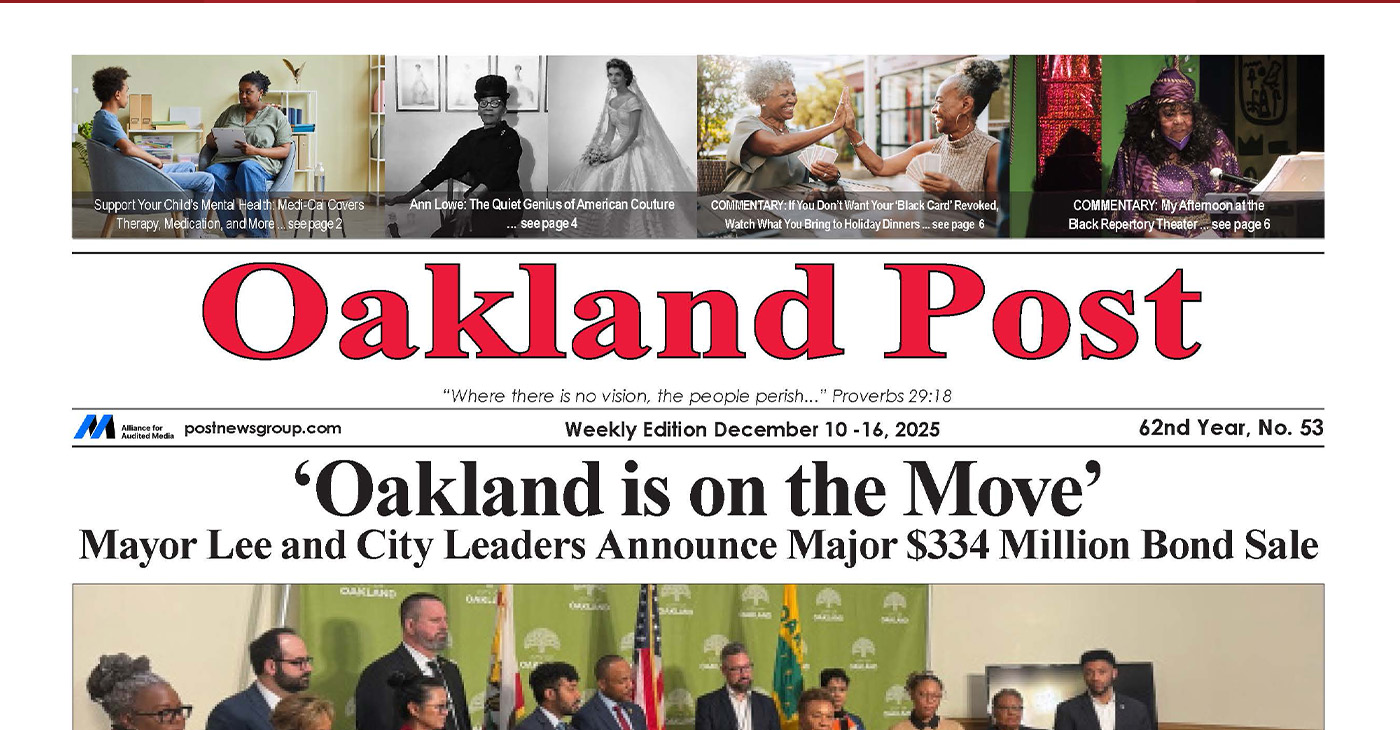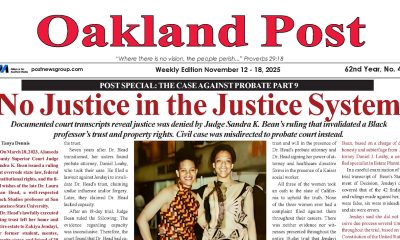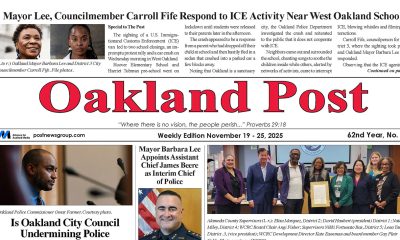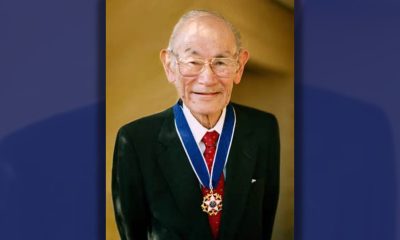National
Rosa Parks’ Archive Opening to Public at Library of Congress

A photograph of Rosa Parks circa the 1950’s and a paper written by Parks about segregation are some of the items in the Rosa Parks archive, seen during a media preview at the Library of Congress, Madison Building, in Washington, Thursday, Jan. 29, 2015. (AP Photo/Jacquelyn Martin)
BRETT ZONGKER, Associated Press
WASHINGTON (AP) — Rosa Parks, who refused to give up her seat on a segregated bus, reflected later on how it felt to be treated less than equal and once feistily wrote of how tired she was of being “pushed around” — parts of her history long hidden away.
Beginning Wednesday at the Library of Congress, researchers and the public will have full access to Parks’ archive of letters, writings, personal notes and photographs for the first time. The collection will provide what experts call a more complex view of a woman long recalled in history for one iconic image — that of a nonviolent seamstress who inspired others to act at the dawning of the civil rights era.
A protracted legal battle between her heirs and friends had kept the collection from public view for years. But in 2014, philanthropist Howard Buffett bought the collection and placed it on long-term loan at the national library. The Associated Press has previously reported on the legal wrangling that kept Parks’ archive warehoused for years. Until now, scholars have had very limited, if any, access to the materials.
“I think it’s one of the first times we’re actually able to read her voice, and it just totally goes against this image of the quiet seamstress,” said Margaret McAleer, an archivist at the library. “Her writings are phenomenally powerful.”
Parks, who died in 2005 at 92, is beloved in American history for her civil disobedience on a Montgomery, Alabama bus. That defining moment in 1955 triggered a yearlong bus boycott that helped dismantle a system of segregation.
“I had been pushed around all my life and felt at this moment that I couldn’t take it anymore,” she wrote. “When I asked the policeman why we had to be pushed around, he said he didn’t know. ‘The law is the law. You are under arrest.’ I didn’t resist.”
Parks also wrote of feeling lonely and lost living through the struggle with segregation.
After her arrest, Parks lost her job as a tailor at Montgomery’s largest department store because of her activism. Her husband, Raymond, lost his job, too, and the couple sank into deep poverty. They moved to Detroit but continued to struggle.
She traveled with the NAACP, pressing for civil rights, and eventually landed a job at the Hampton Institute in Virginia earning $3,700 a year — enough to send some money home to her husband and mother. It wasn’t until 1965 when Parks was hired for the district office of Michigan Rep. John Conyers that she finally earned a steady, living wage, archivists said.
Parks’ archive provides scholars and the public with a fuller sense of her life and faith, her personality and her pain, said library historian Adrienne Cannon.
“It’s important because we see Rosa Parks in a kind of almost frozen, iconic image — a hero that is not really real flesh and blood,” Cannon said. “Here we get a sense of a woman that is really full flesh and blood.”
The collection may surprise people by revealing Parks had an aggressive edge and supported more radical actions seeking equality over the years, archivists said. She used her symbolic status to support Malcolm X, Black Panther gatherings and the Wilmington 10 in North Carolina.
“She was so deeply opposed to segregation that as the younger generation came along, she didn’t hold back from them. She was in the fight,” said Helena Zinkham, the library’s collections director.
The library now holds about 7,500 manuscript items and 2,500 photographs from Parks, including the Bible she kept in her pocket, letters from admirers and her Presidential Medal of Freedom. A small exhibit is planned for March. All the items will be digitized and posted online.
Artifacts such as Parks’ clothing, furniture and a pillbox hat she may have worn on the Montgomery bus, will find homes elsewhere. The library plans to place them with other museums or institutions that can conserve and display Parks’ belongings. The library already is in talks with the Smithsonian’s National Museum of African-American History and Culture, now under construction on the National Mall, to possibly house some of the items.
___
Follow Brett Zongker on Twitter at https://twitter.com/DCArtBeat.
Copyright 2015 The Associated Press. All rights reserved. This material may not be published, broadcast, rewritten or redistributed.
Activism
Oakland Post: Week of December 10 – 16, 2025
The printed Weekly Edition of the Oakland Post: Week of – December 10 – 16, 2025

To enlarge your view of this issue, use the slider, magnifying glass icon or full page icon in the lower right corner of the browser window.
Alameda County
Seth Curry Makes Impressive Debut with the Golden State Warriors
Seth looked comfortable in his new uniform, seamlessly fitting into the Warriors’ offensive and defensive system. He finished the night with an impressive 14 points, becoming one of the team’s top scorers for the game. Seth’s points came in a variety of ways – floaters, spot-up three-pointers, mid-range jumpers, and a handful of aggressive drives that kept the Oklahoma City Thunder defense on its heels.

By Y’Anad Burrell
Tuesday night was anything but ordinary for fans in San Francisco as Seth Curry made his highly anticipated debut as a new member of the Golden State Warriors. Seth didn’t disappoint, delivering a performance that not only showcased his scoring ability but also demonstrated his added value to the team.
At 35, the 12-year NBA veteran on Monday signed a contract to play with the Warriors for the rest of the season.
Seth looked comfortable in his new uniform, seamlessly fitting into the Warriors’ offensive and defensive system. He finished the night with an impressive 14 points, becoming one of the team’s top scorers for the game. Seth’s points came in a variety of ways – floaters, spot-up three-pointers, mid-range jumpers, and a handful of aggressive drives that kept the Oklahoma City Thunder defense on its heels.
One of the most memorable moments of the evening came before Seth even scored his first points. As he checked into the game, the Chase Center erupted into applause, with fans rising to their feet to give the newest Warrior a standing ovation.
The crowd’s reaction was a testament not only to Seth’s reputation as a sharpshooter but also to the excitement he brings to the Warriors. It was clear that fans quickly embraced Seth as one of their own, eager to see what he could bring to the team’s championship aspirations.
Warriors’ superstar Steph Curry – Seth’s brother – did not play due to an injury. One could only imagine what it would be like if the Curry brothers were on the court together. Magic in the making.
Seth’s debut proved to be a turning point for the Warriors. Not only did he contribute on the scoreboard, but he also brought a sense of confidence and composure to the floor.
While their loss last night, OKC 124 – GSW 112, Seth’s impact was a game-changer and there’s more yet to come. Beyond statistics, it was clear that Seth’s presence elevated the team’s performance, giving the Warriors a new force as they look to make a deep playoff run.
#NNPA BlackPress
LIHEAP Funds Released After Weeks of Delay as States and the District Rush to Protect Households from the Cold
BLACKPRESSUSA NEWSWIRE — The federal government has released $3.6 billion in home heating assistance after a delay that left states preparing for the start of winter without the program’s annual funding.

By Stacy M. Brown
Black Press USA Senior National Correspondent
The federal government has released $3.6 billion in home heating assistance after a delay that left states preparing for the start of winter without the program’s annual funding. The Low-Income Home Energy Assistance Program, known as LIHEAP, helps eligible households pay heating and cooling bills. The release follows a shutdown that stretched 43 days and pushed agencies across the country to warn families of possible disruptions.
State officials in Minnesota, Kansas, New York, and Pennsylvania had already issued alerts that the delay could slow the processing of applications or force families to wait until December for help. In Pennsylvania, more than 300,000 households depend on the program each year. Minnesota officials noted that older adults, young children, and people with disabilities face the highest risk as temperatures fall.
The delay also raised concerns among advocates who track household debt tied to rising utility costs. National Energy Assistance Directors Association Executive Director Mark Wolfe said the funds were “essential and long overdue” and added that high arrearages and increased energy prices have strained families seeking help.
Some states faced additional pressure when other services were affected by the shutdown. According to data reviewed by national energy advocates, roughly 68 percent of LIHEAP households also receive nutrition assistance, and the freeze in multiple programs increased the financial burden on low-income residents. Wolfe said families were placed in “an even more precarious situation than usual” as the shutdown stretched into November.
In Maryland, lawmakers urged the Trump administration to release funds after the state recorded its first cold-related death of the season. The Maryland Department of Health reported that a man in his 30s was found outdoors in Frederick County when temperatures dropped. Last winter, the state documented 75 cold-related deaths, the highest number in five years. Rep Kweisi Mfume joined more than 100 House members calling for immediate federal action and said LIHEAP “is not a luxury” for the 100,000 Maryland households that rely on it. He added that seniors and veterans would be placed at risk if the program remained stalled.
Maryland Gov. Wes Moore used $10.1 million in state funds to keep benefits moving, but noted that states cannot routinely replace federal dollars. His administration said families that rely on medical equipment requiring electricity are particularly vulnerable.
The District of Columbia has already mapped out its FY26 LIHEAP structure in documents filed with the federal government. The District’s plan shows that heating assistance, cooling assistance, weatherization, and year-round crisis assistance operate from October 1 through September 30. The District allocates 50 percent of its LIHEAP funds to heating assistance, 10 percent to cooling, 13 percent to year-round crisis assistance, 15 percent to weatherization, and 10 percent to administrative costs. Two percent is used for services that help residents reduce energy needs, including education on reading utility bills and identifying energy waste.
The District’s plan lists a minimum LIHEAP benefit of $200 and a maximum of $1,800 for both heating and cooling assistance. Crisis benefits are provided separately and may reach up to $500 when needed to resolve an emergency. The plan states that a household is considered in crisis if it has been disconnected from energy service, if heating oil is at 5 percent or less of capacity, or if the household has at least $200 owed after the regular benefit is applied.
The District’s filing notes that LIHEAP staff conduct outreach through community meetings, senior housing sites, Advisory Neighborhood Commissions, social media, posters, and mass mailings. The plan confirms that LIHEAP applicants can apply in person, by mail, by email, or through a mobile-friendly online application and that physically disabled residents may request in-home visits.
As agencies nationwide begin distributing the newly released funds, states continue working through large volumes of applications. Wolfe said LIHEAP administrators “have been notified that the award letters have gone out and the states can begin to draw down the funds.”
-

 Activism4 weeks ago
Activism4 weeks agoOakland Post: Week of November 12 – 18, 2025
-

 Activism3 weeks ago
Activism3 weeks agoIN MEMORIAM: William ‘Bill’ Patterson, 94
-

 Activism4 weeks ago
Activism4 weeks agoHow Charles R. Drew University Navigated More Than $20 Million in Fed Cuts – Still Prioritizing Students and Community Health
-

 Bay Area4 weeks ago
Bay Area4 weeks agoNo Justice in the Justice System
-

 #NNPA BlackPress3 weeks ago
#NNPA BlackPress3 weeks agoBeyoncé and Jay-Z make rare public appearance with Lewis Hamilton at Las Vegas Grand Prix
-

 #NNPA BlackPress3 weeks ago
#NNPA BlackPress3 weeks agoLewis Hamilton set to start LAST in Saturday Night’s Las Vegas Grand Prix
-

 Activism3 weeks ago
Activism3 weeks agoOakland Post: Week of November 19 – 25, 2025
-

 #NNPA BlackPress4 weeks ago
#NNPA BlackPress4 weeks agoThe Perfumed Hand of Hypocrisy: Trump Hosted Former Terror Suspect While America Condemns a Muslim Mayor


















































